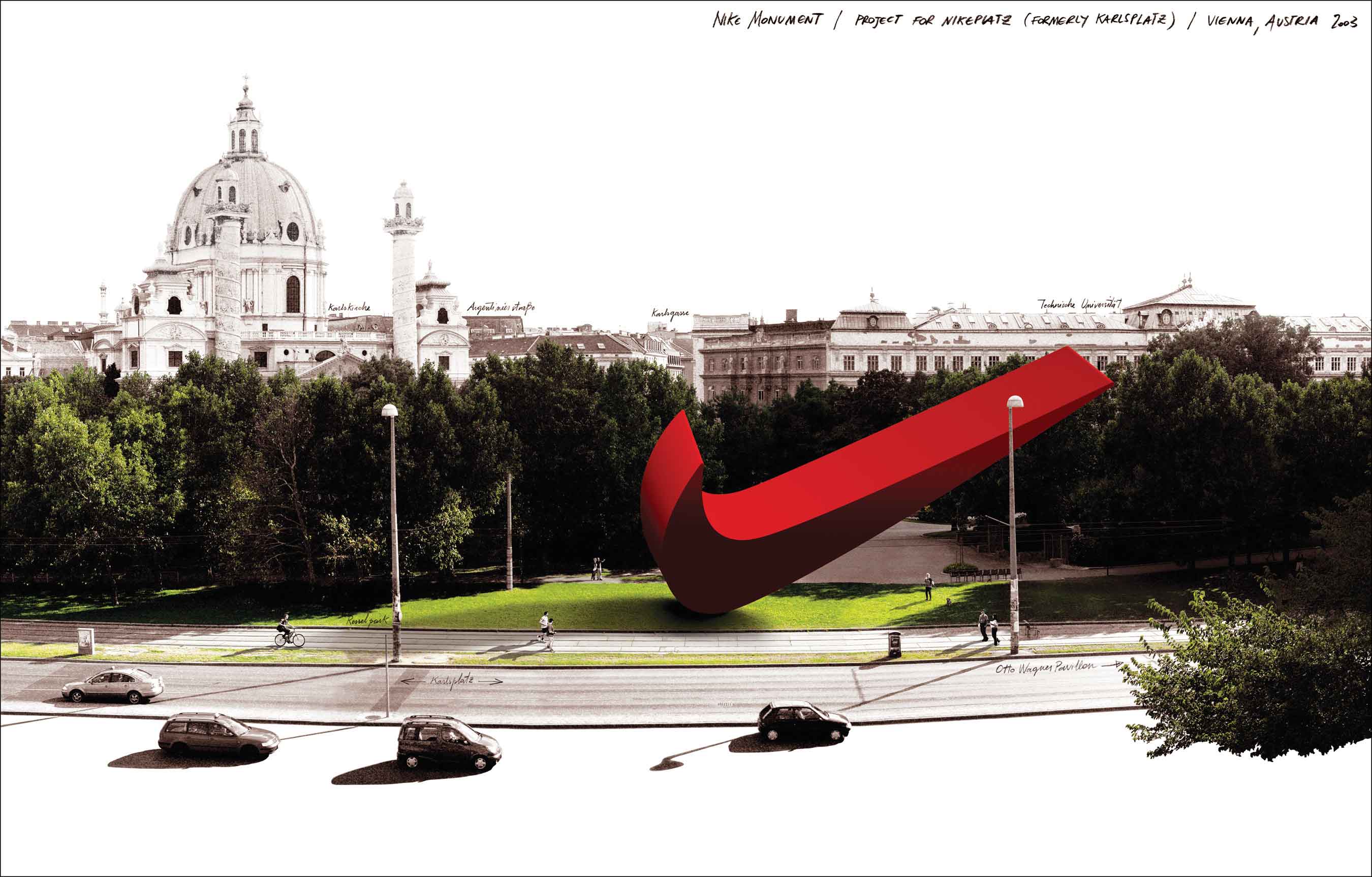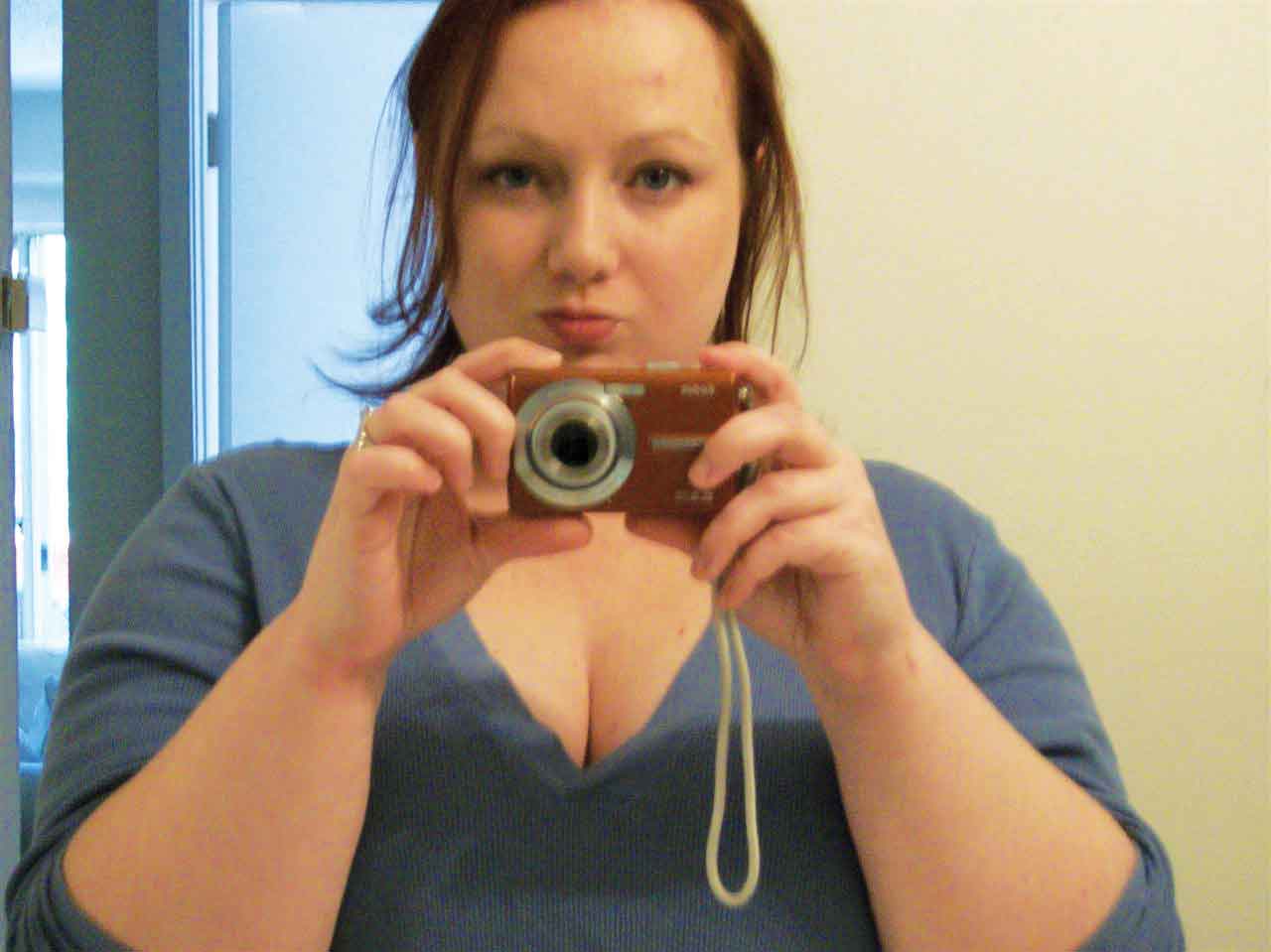« Features
Eva & Franco Mattes: Attribution Art?

Eva and Franco Mattes aka 0100101110101101.ORG. Project for the fake Nike Monument in Karlsplatz, 2003, print on canvas, 38” x 52.” Courtesy Postmasters Gallery, New York
Thanks to a friend, I recently read an impressive Walter Benjamin quote: “To a book collector, you see, the true freedom of all books is somewhere on his shelves.” I loved it, because it is very telling of what I think not just about collecting, but also about appropriation, theft, and curating. All these actions have to do with taking something made by somebody else and making it your own property, legally or illegally.
Along with Benjamin, I believe that when you do this, you are actually freeing the object you take, allowing it to be more than just what it was in the intentions of its creator: more than just a photo documentation of a Rasta community, as in Richard Prince’s appropriation of Patrick Cariou’s work; more than just a toy, like in many Jeff Koons works; more than just a Walker Evans photo, like in the work of Sherrie Levine.
Eva and Franco Mattes are a couple of Italian-born, New York-based artists who made their first appearance on the Internet, under the label 0100101110101101.ORG. Their work has much to do with theft: recently, they even stole a radioactive ride from the Chernobyl area and reconstructed it in Manchester, United Kingdom. So, when ARTPULSE asked me to interview them, I thought it would have been interesting to interview some of the victims of their thefts instead: not to collect livid reactions, but rather to rouse a positive thinking about the beneficial consequences of this act of appropriation. We all know what they’ve lost; but what did they gain from Eva and Franco’s thefts?
By Domenico Quaranta
Domenico Quaranta - Dirk Paesmans is a Bruxelles-born artist and part of the artist duo Jodi. Started in 1995, their web project jodi.org was a revelation for many artists interested in making art on the Internet. In 1999, Eva and Franco Mattes copied Jodi’s website and published it unchanged on their own, 0100101110101101.ORG. In both cases, the website was the artists’ identity, and this brought the Mattes to take part in some shows in place of Jodi. “Copyright is boring,” they said. Dirk, do you agree?
Dirk Paesmans - I agree. If you don’t want your art to be used by others, then you’d better stay away from the Internet– keep it in your studio and show it in a gallery. On the Internet, if you can see it, you own it. Once you publish something online you are accepting that others may use it. And the other way around: our work is full of stuff we found online: code, images, sounds, it all comes from there and who knows who did it in the first place?
D.Q. - Darko Maver is currently a full-time professor of criminalistics at the Faculty of Criminal Justice, University of Maribor, and at the Faculty of Law, University of Ljubljana. Back in 1998, the Mattes used his name to create the legend of an artist, wandering in decaying Yugoslavia and installing provocative sculptures in public spaces. Darko Maver was supposedly persecuted, arrested, and died in prison in April, 1999. In September, 1999, the Venice Biennale hosted a tribute to the dead artist. I asked the real Darko if he enjoyed this weird celebrity.
Darko Maver - I’m a criminologist, my job is to look at crime scenes to understand them. While, as far as I got, my homonym artist was setting up crime scenes as artworks, sculptures that looked like corpses. There is definitely something connecting our lives other than the name we share.
D.Q. - After resigning from his position of Director of the Holy See Press Office in 2006, Doctor Joaquín Navarro-Valls is now easier to contact. He was there when, in 1999, 0100101110101101.org bought the domain Vaticano.org and played the role of the Holy See for a whole year, rewriting encyclicals, collaging prayers, pop songs and fantasy tales, and hijacking pilgrims. Dr. Navarro-Valls, at the time you had to stop this bad joke. Twelve years later, what do you think about it?
Joaquín Navarro-Valls - Stupidity is also a gift of God, but one mustn’t misuse it.
D.Q. - It was hard, instead, to get in touch with Philip Knight, chairman of Nike. I’m pretty sure that, in the end, my email was replied by a spokesman, but it’s interesting anyway. Mr. Knight, in 2003, Eva and Franco Mattes appropriated the Swoosh logo and the Nike identity, and made a weird advertisement campaign in your place. The action had legal consequences, and Nike lost the battle. Are you still upset?
Philip Knight - Many people compared this case to Andy Warhol using Campbell’s Soup for his paintings, but I don’t see any similarity. Warhol used to eat Campbell’s products and was celebrating its logo as an icon of his time. As far as I know this so called artists, who exploited our brand, don’t even wear our running shoes.
D.Q. - In 2010, Eva and Franco stole from a master of robbery. Using a popular Internet meme as a model, they made a fake Cattelan sculpture, and they showed it as a Cattelan in Texas, before claiming the prank. Maurizio, did they learn from you? And what did you learn from them?
Maurizio Cattelan - They didn’t steal anything from me– what they did is not “appropriation art,” I’d call it “attribution art” instead: they made an artwork and attributed it to me. I somehow feel better about having an idea added to my work than an idea stolen. To me ideas are like bicycles: if you got yours stolen, you are authorized to steal one yourself, but only after they stole yours, otherwise you’re breaking the chain.

Eva and Franco Mattes aka 0100101110101101.ORG. The Others, 2011, 10.000 photos found in personal computers.
D.Q. - One of the last Mattes’ works, The Others (2011), is a slideshow of 10,000 private photos found on personal computers, exploiting a hole in peer-to-peer software. Thanks to the Mattes, I was able to get in touch with Debra …., a 35-year-old woman whose touching photos of her pregnancy ended up in the slideshow. What the Mattes didn’t know when they exhibited The Others in Sheffield, United Kingdom, was that Debra lived there. She went to the opening.
Debra…. - When I realized the person in the photos was me, I was shocked. It was extremely embarrassing; these photos were not meant to be seen by anybody other than me and my family. But I’ve to admit that after viewing the whole work several times, my feelings started changing: I realized the victims of these thefts were not the subjects of derision; there is some kind of celebration in the amateurish way they are projected, maybe it’s the music. I was watching carefully the other visitors in the show and I sensed they had the same feeling. Then I realized that anyone’s life nowadays can be part of an artwork, willingly or unwillingly.
D.Q. - Between 1995 and 1997, the Mattes stole pieces of masterpieces from museums around the world. The first piece was a bottle top from an Edward Kienholz installation…
Edward Kienholz - In principle, I cannot excuse what they did, but I have to admit that I would have never noticed the absence of that bottle top, so I didn’t feel like my work was permanently defaced. One could put it this way: before there was one work, mine; now there are two, mine and theirs. As long as this doesn’t become a trend, I wouldn’t worry too much.
D.Q. - Recently, the Mattes - together with Corazon Del Sol - claimed the authorship of a piece by Dieter Roth exhibited in the show “Another Kind of Vapor” at White Flag Projects, Saint Louis, Missouri: a glass jar containing flies supposedly collected by Dieter Roth during the seminal exhibition “Staple Cheese (A Race)” (Los Angeles, 1970). The story goes that the whole exhibition (a series of 37 suitcases filled with cheese laying on the floor) was later thrown away in the desert by the gallery owner. Is the piece a fake? Or the remake of a lost original, mentioned also on Wikipedia?
Dieter Roth - I wish I had collected the flies myself! Unfortunately I didn’t. I think that the most profound experiences in life can’t be contained by gallery walls. All my life I tried to deal with this by creating art out of decaying materials, being it cheese or chocolate. I’m not surprised nobody doubted the jar with flies was a work of mine, as it resonates with my feeling that all objects in galleries and museum are what remains of the work, they are not the work itself.
D.Q. - Of course, the thieves themselves have been victims of a theft. If you befriended them on Facebook, you may have already realized that they are not the owners of their personal accounts. Back in 2001, when the Mattes were known only by their domain name 0100101110101101.ORG, the German writer and theorist Florian Cramer registered a very similar domain (0100101110110101.ORG), and for a couple of months made artworks and sent emails under that name. So, in order to fulfill the request from ARTPULSE, I asked Eva and Franco Mattes about it.
Eva and Franco Mattes - Plagiarism improves - but it still implies ideas. In the contemporary condition of information overload, the raw surplus of images, ideas and texts has become so great that the selection of material to plagiarize will inevitably be as much “creative” as the construction of those images, ideas and texts in the first place. If the aim of plagiarism is to make a radical break with “originality,” “creativity,” and its commodity value, plagiarists would have to give up the selection process and use some automatic method instead. But even such a method–for example, through a computer algorithm–presupposes artistic choice. It also does not prevent the use of resulting materials for the excess value called art. And if done in the name of established artists, it will just reinforce their brand. For us, “plagiarism,” “fake,” and “art” are just different sides of the same coin. We welcome outside interventions in our name when they perpetuate this perversity. The reverse is true as well: Don’t believe one second that through boycott or mere inactivity you would be able to free yourself from the market scheme of originality and creativity manifested through art and its double, plagiarism.
* Dirk Paesmans, Darko Maver, Joaquín Navarro-Valls, Philip Knight, Maurizio Cattelan, Debra, Edward Kienholz († 1994), and Dieter Roth († 1998) have been kindly played by Eva and Franco Mattes. Eva and Franco Mattes have been kindly played by Florian Cramer.




































Wow Domenico! Fantastic article. So great that you and Florian were able to be in contact with so many people. I think their diverse perspectives on appropriation / attribution / real / fake / identity / all of it, really open this dialog up in a powerful way.
I’ve always loved the Eva & Franco Mattes Charta book that you worked on, and their “stolen” Maurizio Cattelan interview there (which I actually stole and used myself)
“Reality” has had such a fakely stable quality for so long, and works like these by fracturing the illusion of reality, allow, I think, for the chance to discover deeper, more true, more “real” realities.
[...] un artículo para Artpulse Magazine, el crítico italiano Domenico Quaranta ha recogido las declaraciones de algunos de los artistas [...]